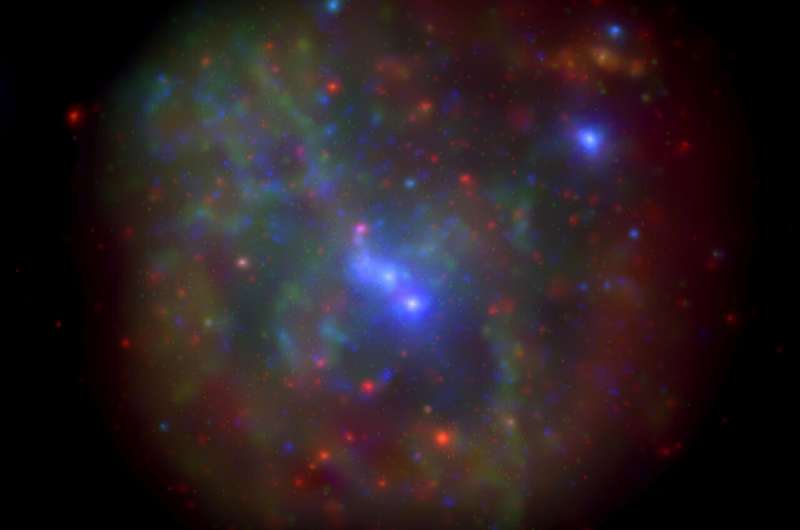This X-ray image of the galactic center merges all Swift observations from 2006 through 2013. Sagittarius A* is at center. Red are low-energy X-rays (300 to 1,500 electron volts). Green are medium-energy (1,500 to 3,000 eV). Blue are high-energy (3,000 to 10,000 eV) in blue. Credit: NASA/Swift/N. Degenaar
The black hole at the center of the galaxy not only flares irregularly from day to day, but also in the long term. This was revealed by an analysis of 15 years of data by an international team of researchers led by Alexis Andres from El Salvador. Andres started his research in 2019 as a summer student at the University of Amsterdam (the Netherlands) and dug into it in the years that followed. The research is to be published in the journal Monthly Notices of the Royal Astronomical Society.
Astronomers have known for decades that Sagittarius A*, the black hole in the center of the Milky Way, flashes every day and sometimes gets 10 to 100 times brighter than normal. To find out more about Sagittarius A*'s flares, an international team of astronomers searched for patterns in 15 years of data. That long data set is available because NASA's Swift satellite has been glancing at the central black hole every three days since 2006.
It turns out that from 2006 to 2008, the area near the black hole was flashing quite a bit. But between 2008 and 2012, it was pretty quiet. And after 2012, the flares increased again.
The researchers could not distinguish a pattern. "So how the flares occur exactly remains unclear," says co-author Jakob van den Eijnden (now University of Oxford (United Kingdom), formerly University of Amsterdam). "It was previously thought that more flares follow after gaseous clouds or stars pass by the black hole, but there is no evidence for that yet. And we cannot yet confirm the hypothesis that the magnetic properties of the surrounding gas play a role either."
Summer school
The research was led by Alexis Andres from El Salvador. He participated in the summer of 2019 as an undergraduate student in the ASPIRE program of the Anton Pannekoek Institute of Astronomy at the University of Amsterdam. In this program, talented students from countries with fewer academic development opportunities work on an astronomical project for a summer. After summer school, Andres returned to El Salvador and devoted himself to this research for two years. He led the international research team from a distance because of the corona restrictions. Andres has been studying for a master's degree in astronomy in Mexico City since August 2021. He wants to become a professional scientist and wishes to bring astronomy to his home country.
Long dataset
"The long dataset of the Swift observatory did not just happen by accident," says co-author Nathalie Degenaar (University of Amsterdam). She was the supervisor of Andres and Van den Eijnden during the summer school. While Degenaar was doing her Ph.D., NASA granted her request for the measurements. "And since then, I've been applying for prolongation regularly. It's a very special observing program that allows us to conduct a lot of research."
Over the next few years, the astronomers expect to gather enough data to be able to rule out whether the variations in the flares near Sagittarius A* are due to passing gaseous clouds or stars, or whether something else is going on.
Sagittarius A*
Sagittarius A*, (in short Sgr A*, pronounced "saj a-star") the black hole at the center of the galaxy, is located in the direction of the constellation Sagittarius as seen from Earth. Astronomers have been studying the black hole's environment for years. For example, half of the Nobel Prize in Physics in 2020 went to researchers who had spent years tracking the stars that circle the black hole. And an international team of astronomers, with a large share from the Netherlands, is trying to take a picture or a movie of the direct surroundings of the black hole using the Event Horizon Telescope. Partly because this black hole flares so unpredictable, it is a lot harder to image than, for example, the black hole in galaxy M87, of which the first picture was published in 2019.
More information: A Swift study of long-term changes in the X-ray flaring properties of Sagittarius A*. Accepted for publication in the Monthly Notices of the Royal Astronomical Society.
Journal information: Monthly Notices of the Royal Astronomical Society
Provided by Netherlands Research School for Astronomy
























